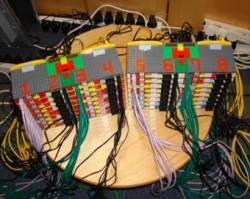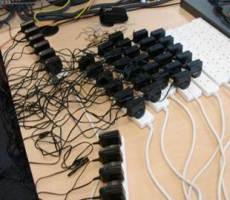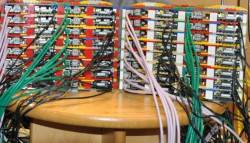Raspberry Pi powered supercomputer opens way for educators

![]() The Iridis-Pi supercomputer comprises two Lego-based towers of 32 Raspberry Pis each
The Iridis-Pi supercomputer comprises two Lego-based towers of 32 Raspberry Pis each
Source: Professor Simon Cox
Teaching students how to assemble a modern supercomputer has not been simple or economical, but thanks to the Raspberry Pi, students at Southampton University will now be able to work with a low cost supercomputer cluster where they can learn the techniques involved hands on. Professor Simon Cox of the University's Computational Engineering Department and a team of students put together 64 Raspberry Pis running the Raspbian variant of Debian Linux and a port of MPICH2, the portable Message Passing Interface software, to create a computing cluster.
The cluster, excluding the Ethernet switches that connect the boards together, costs under £2,500 and, with 16GB Class 10 SD cards in each Pi, has a terabyte of storage and is able to run off a single 13 Amp mains socket. A more traditional computational cluster would have used 64 PC class or greater systems, each using its own mains socket and taking up far more space; using Raspberry Pi boards brings the endeavour down to classroom scale.

![]() Although it can be powered from one 13 Amp socket, getting the power to the Pis still involves numerous adaptors
Although it can be powered from one 13 Amp socket, getting the power to the Pis still involves numerous adaptors
Source: Professor Simon Cox
Given the size of the boards, racking them was going to be somewhat difficult, but with the specialist Lego support from his son James, Professor Cox's team created a Lego based rack custom built for the Raspberry Pis. Then, using Python Tools for Visual Studio, they created the first test application for the "Iridis-Pi" supercomputer to calculate, appropriately, the value of Pi.
Professor Cox told The H that they've done no systematic testing of the system as yet; however, the Raspberry Pi Foundation estimates the CPU power of a single Pi at around that of a 300 Mhz Pentium II. "The processor is probably not the place to get performance from on the Pi. There is much more on the graphics side" says Cox, noting that people are starting to look at exploiting that. The core OS is still being tuned up, but Cox notes that the 100Mb Ethernet on the Pi actually hangs off the USB interface, which may limit the rate at which the boards can talk to each other.

![]() The grey and green cables here go to the Ethernet switches, not shown, that interconnect the Raspberry Pis
The grey and green cables here go to the Ethernet switches, not shown, that interconnect the Raspberry Pis
Source: Professor Simon Cox
In bringing the idea of computational clusters down to classroom scale, the project has given students the ability to learn about parallel programming at a price point previously unheard of and to create real applications running on raw hardware – it "brings a whole new generation that can be inspired and enabled to get into computational science and engineering". Cox says the team are now working to "really understand system performance and use other parts of the architecture in some innovative ways" and he hopes the project will inspire others to do something innovative with the idea themselves or use it to teach the next generation of engineers and scientists.
The project has its own page on the University web site that carries step by step instructions how to build a master copy of the Raspbian-based software for the nodes, how install MPI and how to create the custom images for the nodes. It also includes links to the tools used to create the applications that have been run on the Iridis-Pi system.
(djwm)
![Kernel Log: Coming in 3.10 (Part 3) [--] Infrastructure](/imgs/43/1/0/4/2/6/7/2/comingin310_4_kicker-4977194bfb0de0d7.png)

![Kernel Log: Coming in 3.10 (Part 3) [--] Infrastructure](/imgs/43/1/0/4/2/3/2/3/comingin310_3_kicker-151cd7b9e9660f05.png)
















